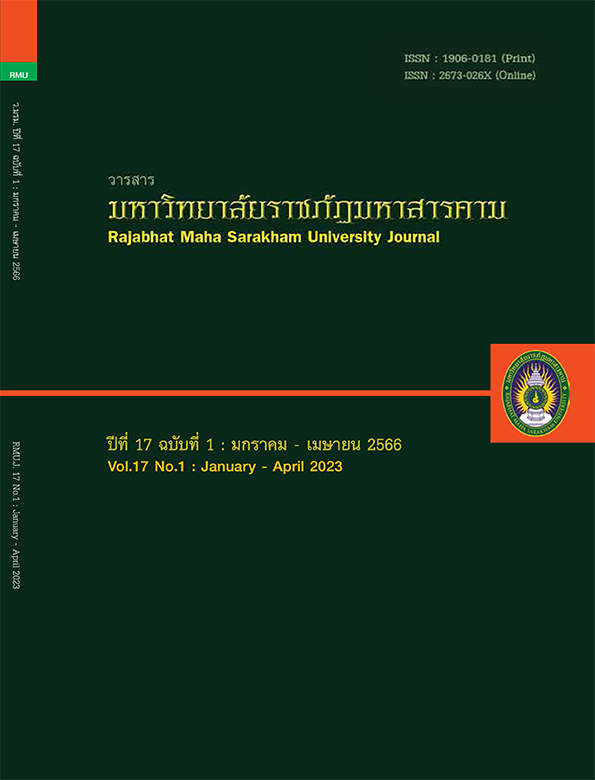Outcomes of Learning Management Using Open Approach Together with Creative Problem Solving Processes Affecting Problem Solving and Mathematical Creativity of Matthayomsuksa 4 Students
Main Article Content
Abstract
The objectives of this research were 1) to compare problem-solving abilities and mathematical creativity of Mathayomsuksa 4 students on probability; After receiving the open learning management with creative problem solving process according to the criteria of 70 percent and 2) to compare the problems. problem-solving and creative abilities Mathematics subjects of Mathayomsuksa 4 students on probabilities before and after were dealt with using an open approach combined with a creative problem solving process. The sample group was students. Mathayomsuksa 4, semester 2, academic year 2021, Yang Talat Wittayakhan School It was obtained from a random group of 1 classroom with 35 students. Research tools were: 1) Open learning management plan with creative process, 5 learning plans, totaling 10 hours, with an average of 4.73-4.77, in a reasonable level. the most It was a subjective type of 3 items with the Index of Consistency (IOC) between 0.67-1, difficulty (p) between 0.55-0.62, discriminating power (r) between 0.30-0.41 and the reliability of the whole version equal to 0.99. Mathematical creativity was subjective, 4 items, index of consistency (IOC) from 0.67 - 1, difficulty value (p) between 0.58-0.62, discrimination power (r) between 0.34-0.38, and reliability of the whole article was 0.97 ways. Statistics used in data analysis were percentage, mean, standard deviation, t-test for one sample and independent t-test for dependent samples.
The results were as follows: 1. Mathayomsuksa 4 students after receiving the mathematics learning management method; 2. Mathayomsuksa 4 students after receiving open learning with creative problem-solving process. had the ability to solve problems and creativity in mathematics higher than 70% with a statistical significance at the .05 level. Students who are open-minded to creative problem-solving have higher problem-solving abilities and mathematics creativity than ever before. Statistically significant at the .05 level.
Article Details

This work is licensed under a Creative Commons Attribution-NonCommercial-NoDerivatives 4.0 International License.
1. All articles undergo a thorough with at least three reviewers evaluating their suitability within the respective field of study, during the double-blind review.
2. The views expressed by individual authors do not represent the official views of the Editorial Boards of RMUJ: The author of each articie is responsible for all its contents.
3. The Editorial Boards do not reserve the copyrights. but proper citations need to be made.
References
ขจรศักดิ์ สีเสน. (2544). การแก้ปัญหาด้วยกระบวนการคิดสร้างสรรค์. วารสารวิชาการ, 4, 1 (มกราคม 2544), 14-19.
จรีย์ สุวัตถี. (2534). กล้าคิด กล้าเผชิญ. นครนายก:มหาวิทยาลัยศรีนครินทรวิโรฒ ประสานมิตร.
ดารินทร์ งามสันเทียะ. (2563). การพัฒนาความสามารถในการแก้ปัญหาและความคิดสร้างสรรค์ทางคณิตศาสตร์ เรื่อง ความน่าจะเป็นของเหตุการณ์ โดยใช้กระบวนการแก้ปัญหาเชิงสร้างสรรค์ของนักเรียนชั้นมัธยมศึกษาปีที่ 3. วารสารศึกษาศาสตร์ มหาวิทยาลัยขอนแก่น, 43(3), 15-49.
ทรงศักดิ์ ภูสีอ่อน. (2561). การวิจัยและพัฒนาทางการศึกษา. มหาสารคาม: ตักสิลาการพิมพ์.
บุญชม ศรีสะอาด. (2545). การวิจัยเบื้องต้น. กรุงเทพฯ: สุวีริยา สาส์น.
ไพศาล วรคำ. (2559). การวิจัยการศึกษา (พิมพ์ครั้งที่ 8). มหาสารคาม: ตักสิลาการพิมพ์.
พัทธยากร บุสสยา. (2559). ผลการจัดกิจกรรมการเรียนรู้โดยใช้วิธีการแบบเปิด ที่มีต่อความสามารถในการแก้ปัญหา และความคิดสร้างสรรค์ทางคณิตศาสตร์ของนักเรียนชั้นมัธยมศึกษาปีที่ 5. วารสารศึกษาศาสตร์ มหาวิทยาลัยบูรพา, 27(3), 133-146.
ไมตรี อินทร์ประสิทธิ์. (2547, มกราคม-มิถุนายน). การสอนโดยใช้วิธีการแบบเปิดในชั้นเรียนญี่ปุ่น.KKU Journal of Mathematics Education 1. (1), 1-9.
ลักขณา สริวัฒน์. (2549). การคิด (พิมพ์ครั้งที่ 1). กรุงเทพฯ:โอ.เอส. พริ้นติ้ง เฮ้าส์.
วิจารณ์ พานิช. (2557). Open Approach-วิธีประยุกต์การ เรียนรู้แบบ Active Learning สู้การเรียนรู้ ในศตวรรษที่ 21. สืบค้นจาก https://www.gotoknow.org/posts/568714
วิชาการ, กรม. กระทรวงศึกษาธิการ. (2545ก). หลักสูตร การศึกษาขั้นพื้นฐานพุทธศักราช 2544 (พิมพ์ครั้งที่ 2). กรุงเทพฯ: องค์การรับส่งสินค้าและพัสดุภัณฑ์.
สถาบันส่งเสริมการสอนวิทยาศาสตร์และเทคโนโลยี. (2561).ผลการประเมิน PISA 2015 วิทยาศาสตร์ การอ่านและคณิตศาสตร์ ความเป็นเลิศและความเท่าเทียมทางการศึกษา. กรุงเทพฯ: ซัคเซสพับลิเคชั่น.
อัมพร ม้าคนอง. (2547). หลักการและแนวทางการจัดการเรียนรู้กลุ่มสาระการเรียนรู้คณิตศาสตร์. กรุงเทพฯ: จุฬาลงกรณ์มหาวิทยาลัย.
Becker, J.P; & Shimada, S. (1997). The Open-Ended Approach: A New Proposal for Teaching Mathematics. Virginia: National Council of Teachers of Mathematics.
Nohda, N. (n.d.). A study of “open approach” method in school mathematics teaching: Focus on mathematical problem solving activities & emclesh. Ibaraki: Institute of Education, University of Tsukuba.
Pehkonen, E. (1997). Use of open-ended problems in mathematics classroom. Helsinki: Department of Teacher Education University of Helsinki.
Polya, G. (1957). How to solve it. Princeton, NJ: Princeton University.
Schoenfeld, A.H (1985). Mathematical Problem Sloving. San Diego Californai: Academic Press.


